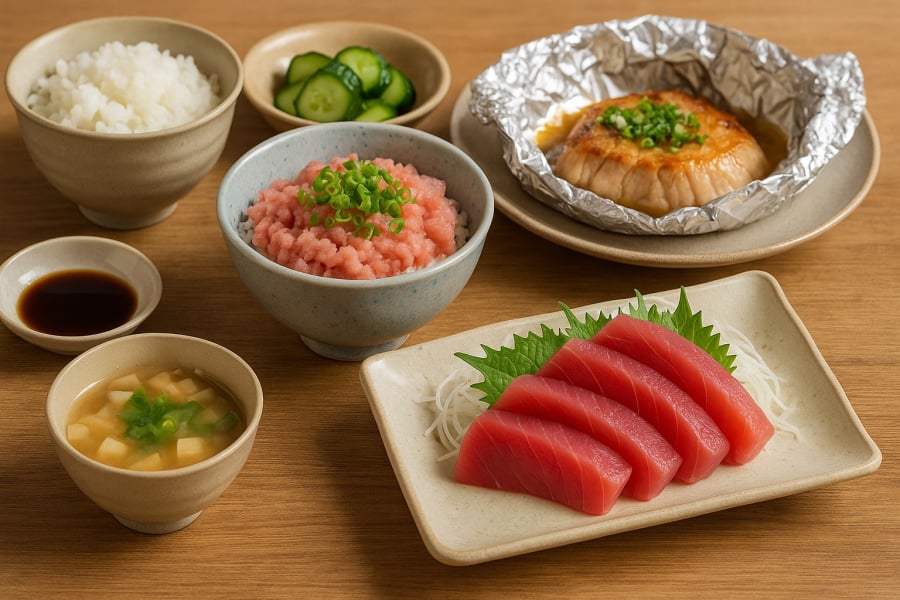Yellowfin Tuna: A Japanese Delicacy
If you’ve ever lived with a Japanese family, you’ll quickly notice that yellowfin tuna, or maguro, is a staple in their daily meals, appearing in various dishes from breakfast to dinner, whether raw or cooked. While it may not be as vibrant as salmon, yellowfin tuna has captured the hearts of many with its mild flavor, ease of cooking, and affordability.
According to statistics from Japan’s Ministry of Agriculture, Forestry, and Fisheries, tuna is one of the three most consumed seafood products annually. This popularity stems not only from its delicious taste but also from its impressive nutritional value—a true “treasure” for one’s health.
Nutrition as Precious as Gold for Heart Health and Skin
What makes yellowfin tuna a “national” favorite is its high content of omega-3 fatty acids, well-known for their ability to reduce bad cholesterol, support blood circulation, and prevent cardiovascular diseases.
Specifically, 100g of fresh yellowfin tuna contains:
- 1.2-1.5g of omega-3 fatty acids (EPA & DHA) to reduce inflammation in blood vessels and prevent atherosclerosis.
- 20-25g of high-quality protein to provide sustainable energy and aid in muscle recovery.
- Vitamins D and B12, selenium, and magnesium to boost the immune system, improve memory, and promote healthy skin.
Dr. Yamada Kenji, a cardiologist in Tokyo, asserts, “Consuming yellowfin tuna 3-4 times a week can reduce the risk of coronary heart disease by up to 20%. For the elderly, it is also a food that effectively prevents nerve degeneration.”
Additionally, the omega-3 content in yellowfin tuna contributes to supple and youthful skin, a reason why many Japanese women consider it a “secret” to aging gracefully from the inside out.

How Do the Japanese Eat Tuna Every Day Without Getting Bored?
You might be surprised to learn that many Japanese people enjoy tuna at every meal and still relish it. The secret lies in the diverse and refined ways of preparing it. Here are some popular dishes in Japanese households:
- Sashimi: Thinly sliced raw tuna served with soy sauce and wasabi. This dish preserves the natural sweetness of the fish, is easy to digest, and requires minimal seasoning.
- Negitoro don: Minced tuna mixed with scallions and a mild vinegar, served with hot rice. A refreshing dish characteristic of summer.
- Miso-marinated grilled tuna or shioyaki (grilled with ginger and soy sauce): When it comes to cooked tuna, these two options are excellent choices.
- Tuna salad: A blend of steamed tuna, cabbage, seaweed, and roasted sesame seeds—a light and detoxifying dish.
Nutritionist Suzuki Emi explains, “Tuna has a mild, non-greasy flavor, making it easy to pair with various dishes. This is why the Japanese can eat tuna for several consecutive days without feeling overwhelmed, as they might with other oily fish.”
Tips for Selecting and Storing Fresh Yellowfin Tuna
To ensure nutritional quality, proper selection and storage are crucial:
- Choosing yellowfin tuna: The meat should be bright red, not dark or watery. The fresher the fish, the firmer the meat and the less pungent the smell.
- Storage: Tuna should be kept cold at 0-4°C if consumed within 24 hours. For longer storage, freeze immediately and thaw slowly in the fridge to prevent moisture loss.
- Avoid frequent raw consumption unless the source is guaranteed safe and hygienic.

How Much Tuna Should You Eat Weekly?
According to the recommendations of the Japanese Nutrition Institute, adults should consume approximately 300-400g of yellowfin tuna weekly, equivalent to 3-4 small meals. Especially for those with high cholesterol or at risk of cardiovascular disease, yellowfin tuna is an ideal alternative to red meat.
Additionally, postpartum women or those experiencing work-related stress can benefit from regularly including yellowfin tuna in their diets to enhance memory and reduce fatigue.
Conclusion
While salmon is often reserved for special occasions, yellowfin tuna quietly yet persistently finds its way into everyday Japanese meals—like a trusted companion caring for one’s health. If you’re seeking a delicious and nutritious addition to your menu, beneficial for your heart and overall well-being, yellowfin tuna is the ideal candidate.
Unveiling Nordic Naturals: The Omega-3 Journey from Sea to America’s Favorite Brand.
As per Spins Live Vibrantly statistics, Nordic Naturals is the leading brand in the United States for sales and volume in the Omega-3 supplements category. This data is aggregated over 52 weeks, up to March 2025, from various channels, including SPINS Total US Natural Enhanced, Total US MULO, E-commerce, Vitamins & Supplements, and Amazon.
“The Ultimate Summer Treat: A Fruit That Climbs Over Fence, Nature’s Ultimate Superfood”
This humble fruit is a summer favorite and a versatile ingredient. Beyond its refreshing taste, it can be stir-fried, simmered into a soup, or blended into a cooling drink. Its health benefits are numerous, making it a popular choice for those seeking a nutritious and delicious treat during the warmer months.






































